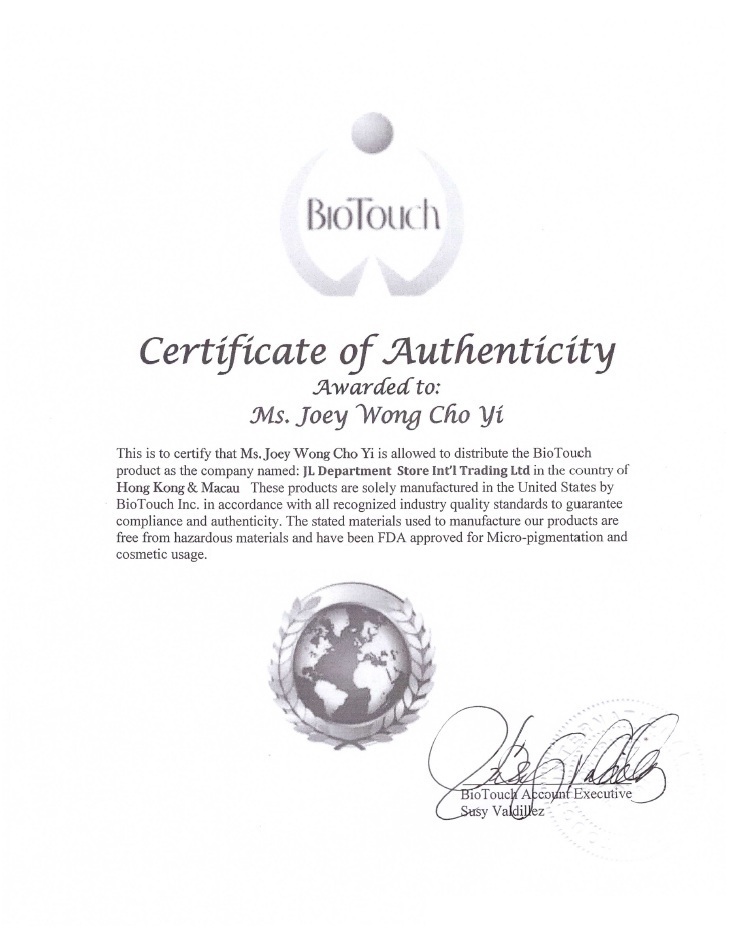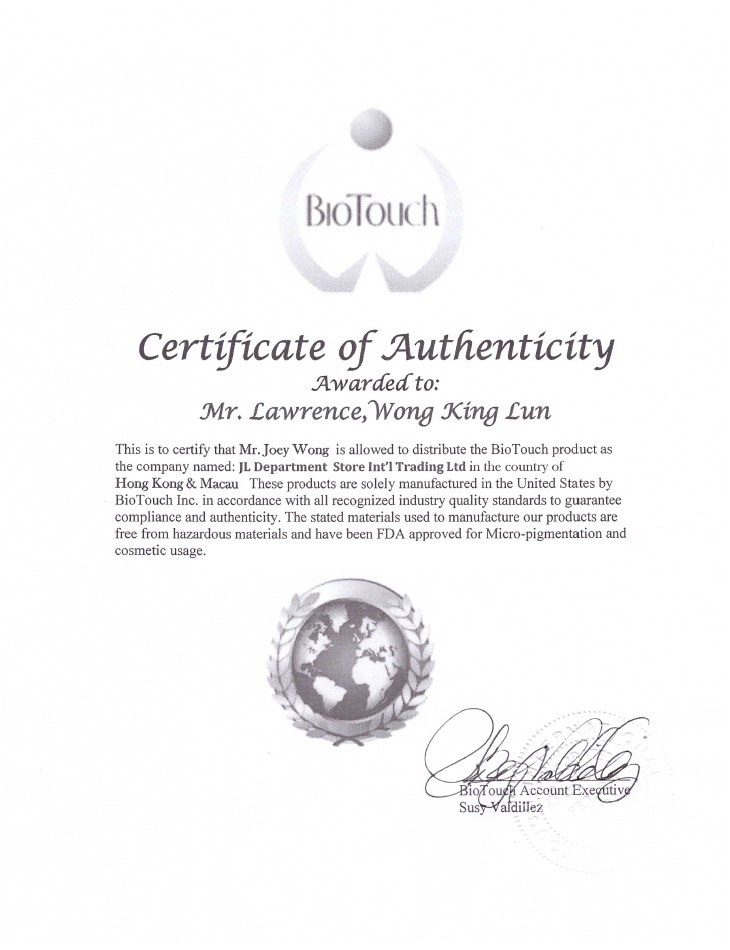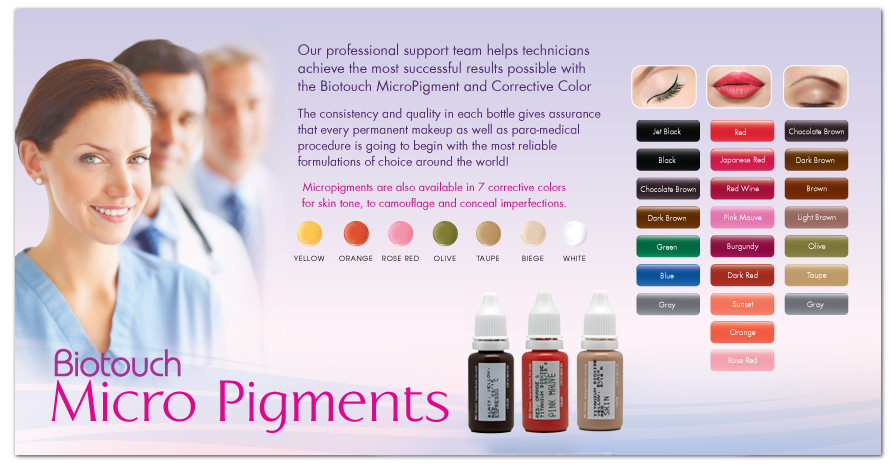BioTouch Academy 歷史介紹
BIOTOUCH的歷史-成立於1980年
美國 (USA) BioTouch Academy 是世界上早期的紋繡學院,學院研發顏料是國際最安全半永久化妝 紋繡色料,達致國際化妝級級別物料 (如現在日本已有85間醫院及整形診所引用此色料),(USA) BioTouch配製顏料都帶有氧化鐵,在半永久化妝操作能安全地在面部及身體上進行顏料 (色乳) 注入。
美國 (USA) BioTouch的顏料裡顆粒子濃度非常高,每滴裡都無數顏料顆粒粒子,使進行半永久化妝操作時更有效地吸收進皮膚。可減低瑕疵的出現,看下去會更真實和實色。
美國 (USA) BioTouch 的顏料也有不同的層次和品質。美國 (USA) BioTouch顏料微粒與乙醇可把乾燥速度較慢,並保持混合物平滑,配合專業半永久化妝師(技術人員)用顏料的工作原理。
現時部份品牌的顏料吹噓自己是有機化合物,但天然並不總是最好的選擇。常見的過敏可以是在有機物質影響。有機染料更有可能對人體帶來不穩定。發現有些品牌甚至在使用工業顏色類似汽車漆!這可能是最危險的,導致人體過敏的嚴重反應。
除了氧化鐵,美國 (USA) BioTouch有名的黑色顏料是有碳成份,在我們每個人身體能自然地發現,因此成份是更適合預防敏感反應。要了解更多關於成分安全的化妝品使用,請訪問iiiStyle.com/ FDA網站 (檔案下載),及你們的當地政府機構及衛生部門。
現時美國 (USA) BioTouch專業半永久化妝(技術人員)已超過50,000在使用我們的美國 (USA) BioTouch產品在33個不同國家。

BioTouch Academy 代表 及 首席 USA Biotouch Master 紋繡大師: Joie WONG and Lawrance WONG


BioTouch Academy 半永久化妝 定妝師技術 常見問題
1. 什麼是永久性化妝?
永久性化妝也稱化妝紋身或微著色,是通過一種細小的無菌一次性針頭在皮膚表面下植入彩色顏料的療程,以產生美容化妝的外觀效果。
2. 永久性化妝和身體紋身有什麼區別?
在BioTouch的永久性化妝程序的目的是提升我們客戶的特徵,不一定會創造突出的藝術作品(如身體紋身)。 永久性化妝更柔和,更微細 - 意味著是一種自然美觀的增強。 身體紋身使用墨水,永久性化妝程序只涉及以氧化鐵為基礎的顏料設計會隨著時間而輕輕褪色。 褪色是需要的,因為它容許技術人員在往後的時間,隨著客戶的自然膚色和面部變化對顏色和形狀進行改變。
3. 永久性程序會否感到疼痛?
在程序前和程序過程中使用高效的局部舒緩膏和凝膠進行舒緩。 疼痛的臨界水平因人而異,會盡一切努力確保您在整個過程中保持舒適。
4. 永久性化妝有多安全?
每個程序都是在嚴格的衛生和消毒規則下完成的。 訓練有素並經過認證的技術人員使用一次性針頭和零件管理每個新程序。 所有顏料都是基於氧化鐵的,並含有美國食品和藥物管理局(FDA)批准的化妝品用成分。
5. 顏料是由什麼製成的?
BioTouch顏料有各種顏色,特別配以氧化鐵,這是一種對皮膚安全的成分。 我們不使用由有機成分製成的顏料,例如蔬菜,因為它們帶有細菌和引起過敏反應的風險很高。 由於顏色植入皮膚真皮層的正下方,所產生的色調柔和,不像位於皮膚表面的常規美容化妝品。
6. 什麼是最常見的療程要求?
最常見的療程是眉毛,眼線,嘴唇和顏色校正/偽裝。 顏色和形狀的設計與客戶的特徵和膚色相匹配並相輔相成。
在沒有毛髮的情況下可以完全重建眉毛,或者可以添加一些"髮”筆以增加稀疏區域的豐滿度 - 選擇柔和的鉛筆外觀或自然的羽毛效果。 永久性化妝可以通過定制塑形增強眉毛的自然特徵。 根據人臉和骨骼結構的形狀,永久性化妝可以替代因年齡和脫髮而失去豐滿度的眉毛,或者為現有眉毛添加定義色調。
眼線筆療程將色素附近的睫毛線添加到睫毛和眼睛輪廓的定義中。 從自然,柔和或污跡的外觀到戲劇性的外觀,線條的粗細和顏色都是為每個客戶定制的。 出於醫學原因進行眼科手術後,我們能夠重新建立平衡並糾正眼部區域的疤痕。
最經常被要求的唇部療程是完整的唇彩或唇線筆。 天然的唇線可以糾正形狀或顏色不對稱以及尺寸。 唇線可以通過創造更加明確的嘴唇形狀來突出唇部,增強豐滿度並為唇部帶來更多的色彩。 由於唇皰疹或受傷而患有唇型不明,嘴唇蒼白而陰沉,嘴唇不均勻或唇部不適的人,都可以從這種療程中受益。 請注意,如果患者唇部或周圍有唇皰疹/發燒水皰/皰疹,則完成唇部療程的患者可能需要處方。
色彩矯正和偽裝 – 化妝紋身可以用來糾正褪色和不需要的顏色,以及偽裝疤痕和重新著色乳暈和乳頭。
7. 我的永久化妝眉毛會看起來自然嗎?
會! 我們的許多客戶報告說,朋友和家人不知道他們曾有療程,儘管他們想知道他們為什麼看起來更年輕。 我們在眉毛上使用柔和的自然色調,以補充每個客戶,並重新創造出有真實頭髮錯覺的髮型。
8. 第一次預約我應該期望什麼?
我們向所有客戶提供免費諮詢。 您可以在不同的日子或同一天安排您的諮詢和療程。 在諮詢過程中,技術人員將討論您的期望以及您希望達到的理想形狀和顏色。 技術人員將進行化妝設計預覽,讓您了解如何照顧整個過程,並提供一些其他風格建議。
9. 永久化妝可持續多久?
治療是永久性的,不會洗掉。 但是,它會隨著時間逐漸消失,並且可能需要每1 - 5年進行一次潤飾。 修飾的頻率取決於許多因素,包括:使用的色素顏色(較淡的顏色會更快消失),生活方式(日光暴曬),缺鐵(您的身體吸收氧化鐵作為補充),以及是否有化學剝離發生在治療區域。
永久性化妝療程的修飾是正常的,每個新療程需要2次訪問。 大約2個月後,首先進行免費的修補程序。 嘴唇可能需要額外的約見。
10. 我在療程前應該做什麼?
雙唇:如果你曾經在唇上或周圍出現過唇皰疹/發燒水皰/皰疹,你必須從你的醫生獲得處方,並告知他/她你有意圖進行唇紋身。在療程前3天和療程後4天開始服用(或遵照醫生的指示)。不服用這種抗病毒藥物可能會導致爆發,反過來會損害你的唇部在療程的效果。
眼線:戴上普通眼鏡,而不是隱形眼鏡。不要使用睫毛膏(特別是防水睫毛膏,因為這樣更難去除,並會使眼睛更加刺激和敏感)。
眉毛:如果你腦海中有一個理想的形狀和顏色,帶上參考照片和眉筆或粉末。
如果您打算休假,建議在此療程後至少10天計劃此行程。 我們還要求我們的客戶在約見前24小時避免使用處方血稀釋劑(如果可能的話)。 這也包括維生素E,阿司匹林和酒精。
11. 我在療程過後會看來怎樣? 康復過程是甚麼?
開首幾天你的永久化妝會顯得比預期的更深和更大。 這將在一周內逐漸減輕。
眼線:預計你的眼睛將會腫脹長達3天(就像你哭泣後一樣)。 需要進行一些小心的保養以使腫脹消退加快。
眉毛:療程後5天,你的眉毛會變得更粗,更暗,直到任何結痂脫落。 該區域也可能是微紅和柔軟的,所以在癒合過程中要對你的皮膚溫和,並繼續使用提供的後續護理產品。
嘴唇:根據個人情況,你的嘴唇看起來非常強烈,並且會變得腫脹2-4天。 4-6天後結痂通常會剝落。 在此期間,顏色看起來很蒼白,只有唇線會顯示淺色。 此時要耐心等待,直到皮膚成熟,需要大約1-2個月的時間,直到看到更自然的結果。
12. 我在療程後應該怎麼做?
我們在您的療程後提供非常具體的護理後指導。 遵循這些說明是非常有益的,以確保良好的癒合過程並獲得最佳結果。 最重要的善後工作是保持經過處理的區域潮濕,不要隨著顏色的剝落擦拭或挑起,並避免高溫(如桑拿房,按摩浴缸,蒸汽房,濕熱的地方)。 對於唇部,繼續使用提供給您的修復產品(作為常規潤唇膏),使顏色持續更久。
13. 我的永久妝容將來會看來怎樣?
我們總是分析我們客戶的皮膚底色,以預測未來顏料的顏色將如何褪色,並且我們混合特殊配方以確保顏色保持相同的色調。 對於我們的大多數客戶來說,他們的永久性妝容保持理想和真實的顏色。 然而,有些情況會根據個人對顏料的反應(如膚色和鐵缺乏)而使顏色逐漸淡化成不同的色調。 影響這些變化的因素很多,在您的隨訪中,我們會分析您的身體對初始顏色的反應。 此時進行特殊的配方更改以糾正顏色並防止顏色進一步變化。
14. 我應該了解哪些關於長期護理的知識?
需要每天在紋身區域使用防曬霜,以保持顏色的真實。 太陽曝曬會使顏色褪得更快。
我們的顏料是基於氧化鐵的。 你的身體吸收它作為礦物質鐵,所以顏色會隨著時間消失。 您可能需要每1 - 5年修補一次。 褪色速度取決於您的皮膚類型,生活方式,日曬,使用顏料的顏色,毛細血管破裂,缺鐵以及永久性化妝後是否有任何化學性脫皮。
如果您正在計劃化學脫皮,MRI或其他醫療程序,請通知技術人員您有氧化鐵化妝紋身。 必須小心應用以避免影響紋身區域。
如果您打算進行激光治療,請告訴您的激光專家避免色素沉著區域。 激光可能導致色素變黑。
15. 我如何找到合適的永久性化妝師來做永久性化妝?
擁有一位熟練的永久性化妝技術員執行這些程序是非常重要的,否則您可能會以永久性的錯誤結束! 與修復質量差的工作相關的時間和費用根本不值得。
1. 找一個有經驗的技術人員。
2. 先諮詢一下:
- 這個地方乾淨又安全嗎?
- 針和附件是否可以一次性使用?
- 形狀和設計工作是否具有藝術品味?
3. 看看技術員工作的非裝飾照片。
4. 詢問參考。

